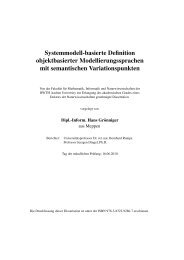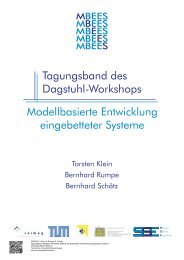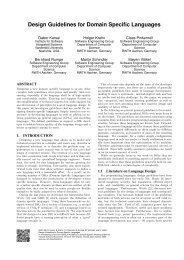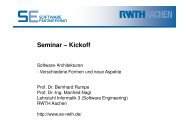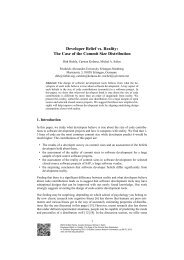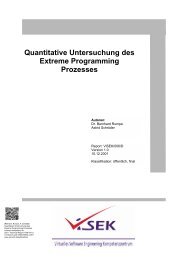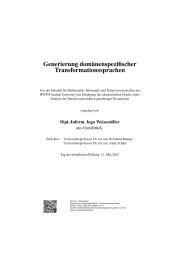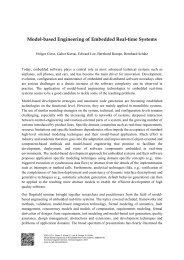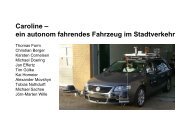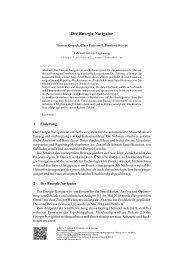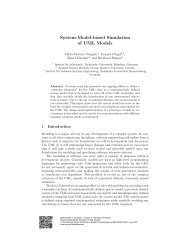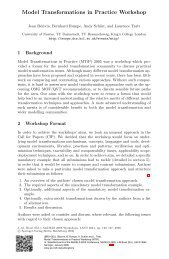View-Based Modeling of Function Nets - Software Engineering
View-Based Modeling of Function Nets - Software Engineering
View-Based Modeling of Function Nets - Software Engineering
You also want an ePaper? Increase the reach of your titles
YUMPU automatically turns print PDFs into web optimized ePapers that Google loves.
ut also by safety or comfort systems like the adaptive<br />
cruise control.<br />
The step from requirements to the actual realization<br />
<strong>of</strong> the system is a complex step that involves a lot<br />
<strong>of</strong> engineering work and coordination between different<br />
developers. Automotive architectures have been<br />
proposed to break down the complexity into manageable<br />
tasks on each architectural layer [2]. An example<br />
is shown in Fig. 1 in which requirements for all<br />
features are transformed into a function net that describes<br />
interacting logical functions that cooperatively<br />
fulfill all the requirements. In the s<strong>of</strong>tware architecture,<br />
logical functions are aggregated or split into deployable<br />
units and detailed signal or function definitions,<br />
e.g., exact data types and value ranges are provided.<br />
On this architectural layer and below the AU-<br />
TOSAR methodology can be applied [1]. The s<strong>of</strong>tware<br />
architecture is then mapped to a technical architecture<br />
consisting <strong>of</strong> ECUs and busses. S<strong>of</strong>tware and<br />
technical architecture constitute the basis for a concrete<br />
realization <strong>of</strong> the final automotive system. In this<br />
paper, we concentrate on the transition from requirements<br />
to function nets.<br />
The automotive system can be seen from two distinct<br />
viewpoints that both describe functions and their<br />
communication:<br />
Feature viewpoint. A set <strong>of</strong> diagrams describes a<br />
single feature. One feature is usually treated separately<br />
from others in the requirements analysis<br />
phases and is realized by one or more functions.<br />
Logical viewpoint. A set <strong>of</strong> diagrams describes a<br />
function and its hierarchical composition in form<br />
<strong>of</strong> an internal structure. The different functions<br />
may be realized on different ECUs and are therefore<br />
developed separately. Nevertheless, they<br />
must cooperate to achieve the common task.<br />
When developing a notation that supports modeling<br />
these viewpoints comprehensibly, we have to keep<br />
in mind that the development process involves many<br />
people with different pr<strong>of</strong>essional backgrounds (like<br />
computer science and engineering) that all need to be<br />
able to use the notation. Further, developing a modeling<br />
language should not be done from scratch but<br />
should be in line with existing standards and reuse<br />
ideas from other works.<br />
Since there is no traceable connection from requirements<br />
to nets <strong>of</strong> logical functions in which the<br />
functionality <strong>of</strong> a feature is not explicitly conceivable,<br />
the development involves extensive re-engineering<br />
when the requirements change.<br />
These observations lead us to the following problem<br />
statement:<br />
a) Which notation is most appropriate, given the<br />
context and the intended use?<br />
b) How can we model the feature requirements<br />
such that the effect <strong>of</strong> changes can easily be analyzed<br />
in the function net?<br />
Figure 1. Complex step from requirements to<br />
system realization<br />
The development is furthermore not being done<br />
from scratch but based on previous models, so a<br />
complete system from an earlier product line is already<br />
available. Typically, in the development <strong>of</strong> the<br />
next product line, changed requirements from various<br />
developers concerning new functions, function redesigns,<br />
or enhancements arise. However, many features<br />
that were present in the previous system will be<br />
reused (maybe in an enhanced version) in the next development<br />
cycle. This calls for a possibility to reuse<br />
functionality on the feature level.<br />
3. Proposed Solution<br />
The demand for models that provide an overview<br />
<strong>of</strong> functions and their interactions on a more abstract<br />
level (logical architecture) than on the s<strong>of</strong>tware and<br />
technical architecture level has also been stressed,<br />
e.g., in [13, 14]. We denote this logical architecture<br />
as function net models.<br />
One standard technique to model complex systems<br />
in a comprehensible way is to use hierarchical models.<br />
This is certainly also appropriate for function nets<br />
since it allows us to model composite logical functions<br />
as a black-box and provide refinements <strong>of</strong> those functions<br />
that model their inner structure in more detail.<br />
As explained above, especially the transition from<br />
the requirements to the function net is complex, because<br />
decisions about how a feature is realized and<br />
2



